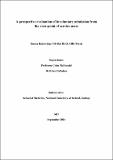A prospective evaluation of involuntary admission from the viewpoint of service users
Date
2016-09-19Author
Bainbridge, Emma
Metadata
Show full item recordUsage
This item's downloads: 603 (view details)
Abstract
Introduction:
Involuntary admission is often a traumatic experience for patients and it is associated with
negative attitudes which can persist after the episode of illness has abated.
Aims:
The aims of the study were to prospectively assess attitudes to care and treatment both at
involuntary admission and when the individual had recovered to their baseline and to identify
clinical predictors of attitudes.
Methods
Consecutively admitted involuntary patients across three psychiatric admission units were
invited to participate in the study. Comprehensive assessments of attitudes and a range of
clinical measures, including symptoms, functioning, insight and care experiences, were
obtained at admission and 3 months after discharge. Attitudes were assessed using the Client
Assessment of Treatment scale (CAT) and a study specific Attitudes Scale to capture aspects
of care and treatment specific to involuntary admission. Multiple linear regression modelling
was used to identify the optimal explanatory variables for attitudes towards care during acute
admission and at the point of recovery to baseline.
Results:
Two hundred and sixty three individual presentations were included at baseline and onehundred
and fifty six (59%) also completed follow-up assessments. Individuals improved
significantly over time both clinically and in their attitudes to their involuntary admission and
treatment. At follow-up, 65.3% stated that they believed that their involuntary admission was
necessary.
A multiple linear main effects regression model demonstrated that at baseline having greater
awareness of illness (b = 0.041, p < 0.001), being older (b = 0.009, p = 0.003), having had
fewer numbers of previous involuntary admissions (b = -0.036, p = 0.001), not having a
lifetime history of illicit substance abuse (b = -0.247, p = 0.048) and having a history of
lifetime alcohol abuse (b = 0.249, p = 0.015) was associated with more positive attitudes
towards involuntary admission and care, adjusting for multiple other factors. Furthermore
greater awareness of illness at baseline (b = 0.042, p = 0.006), male gender (b = -0.280, p =
0.045), not having a history of illicit drug use (b = -0.443, p = 0.012), being older (b = 0.012,
p = 0.014) and having a diagnosis of a non psychotic illness (b = 0.653, p = 0.050) were
7
associated with more positive attitudes towards involuntary treatment and care at follow up.
Over time having a greater improvement in awareness of illness (b = 0.022, p < 0.001), male
gender (b = -0.281, p = 0.014) as well as having a diagnosis of a non psychotic illness (b =
0.732, p = 0.009) was associated with more positive attitudes to involuntary treatment and
care. There was no significant association between experiencing coercive practices such as
seclusion, restraint or forced intramuscular medication and attitudes towards care.
Conclusion:
At the point of recovery most patients considered their involuntary admission as necessary at
the time. Positive attitudes towards involuntary admission and care both at the point of acute
admission and at recovery are better predicted by factors related to the illness and its
treatability, such as awareness of illness and level of symptoms, than factors related to the
service received or extent of coercion employed. Patients who are likely to have persistently
negative attitudes to their care could be identified during the admission phase by their clinical
characteristics and potentially targeted with additional support to ameliorate their negative
experiences.


